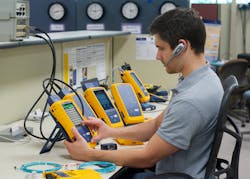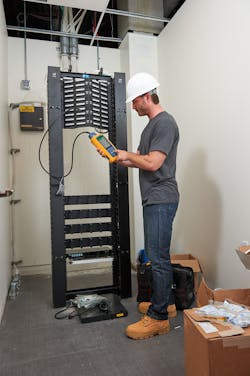Making the business case for cable certification
Every serious installer who completes a structured cabling deployment will test all links in some way to ensure they are properly connected. But is it necessary to fully certify and document the performance of every link?
Certification testing offers significant benefits, and skipping it brings substantial risk. The following five reasons and expert words of wisdom make the case that it's worth fully certifying and documenting every job.
Reason #1: It enables system warranties. While structured cabling accounts for only about 15% of the cost of total network deployment, it also happens to be the most challenging and expensive component to replace, requiring extensive labor and significant disruption to a workplace. Therefore, the structured cabling system should have the longest lifecycle possible—or at least protection from costly replacement due to defects or lack of performance.
Leading cabling system manufacturers offer product warranties that cover individual components against defects. These warranties range from 1 to 5 years, depending on the product. Reputable manufacturers also offer system warranties, sometimes called an extended warranty or application assurance. Most system warranties last 20 or 25 years and guarantee that the structured cabling system will support all current and future applications designed to run on that system—and there's a lot of value in that.
"The structured cabling system is the foundation of the network, and we want our customers to get the most out of their investment and support multiple generations of equipment and applications," says Dave Valentukonis, North American technical services manager for Siemon.
Cabling manufacturers don't hand out cabling system warranties to just anyone. They require bills of materials (BOMs) as proof that every component was theirs, and most necessitate installation by one of their certified installers. Many even require installers to be BICSI certified, with a Registered Communications Distribution Designer (RCDD®) on staff. But the number one requirement to obtain a system warranty is certification testing.
"Certification testing will always be required for warranty, regardless of the number of drops on a project," says Panduit's director of business development Frank Straka. It's not just a Panduit requirement. Belden, CommScope, Corning, Hubbell, Leviton, nCompass (Superior Essex and Legrand), Paige, Siemon, and Signamax (to name a few) all require certification testing for an end user to obtain a system warranty.
"We require 100% certification testing for a system warranty—it gives us objective evidence that our products and systems were installed properly," asserts Valentukonis. One-hundred-percent certification testing means that once installed, every link must be tested to ensure compliance per parameters and channel limits outlined in ANSI/TIA-568 or ISO/IEC 11801 cabling standards (see sidebar). Typically the only exemption is for pre-terminated cabling systems that are pre-tested at the factory. Some manufacturers might not require alien crosstalk testing for Category 6A copper cabling; most only require Tier 1 testing for fiber systems rather than Tier 2.
The ability to offer a system warranty also adds value for installers. It can set them apart from the competition, demonstrate their commitment and expertise, and give their customers peace of mind to keep them coming back.
"There are many ways a cable plant installation can go bad—shipping damage, water or paint getting onto the cable, job site conflicts, inexperienced installers, and more," Panduit's Straka explains. "Certification testing provides value for all stakeholders. End users know they received the system they expected. Our installation partners can leave a job site knowing that the product they installed worked, and if they get a call on a bad link, they have a record of the performance when they left. And Panduit knows that the installation was initially done properly."
Ron Tellas, Belden's technology and applications manager for LANs, points out that warranty programs and certification testing also ensure ROI for certified training programs that account for a substantial percentage of manufacturers' expenses. These programs include trainer salaries, materials, travel expenses, administration, and other operational costs. "Certification testing helps us justify the use of certified installers — it's also something we can attach to good installers and vice versa."
Reason #2: It optimizes troubleshooting. After installing a cable plant, certification testing provides detailed information to troubleshoot problems.
Certification testing can also verify if an existing network will support the needs of a new tenant. "We can often tell right off the bat what we're dealing with by how bad or good the cabling looks, but certification testing is how we can verify if the cabling needs to be replaced—even if we're not doing it for a cable warranty," says Jeff Endemann, RCDD, Tech, small business owner of Ohio-based JE Technical Services.
Certification testing is necessary for technical assistance experts to diagnose more complex problems that aren't readily apparent. Certification testers record all numerical values for every parameter on each link pair and graphically display the results in traces. The selected test limits, calibration date, and software version are also typically included in the results. With Fluke Networks DSX series certification testers, all of this information is saved in a LinkWare FLW file. Only with the results file can installers turn to technical assistance experts for a deeper dive.
"When we get contacted about failures, installers tend to think there must be something wrong with their tester. Often failures turn out to be as simple as choosing the wrong test limits, but if set up correctly and calibrated with the latest firmware, a certification tester almost always does its job. Nothing hides from a LinkWare FLW file—without it, troubleshooting is all theoretical," says Fluke Networks' Technical Assistance Center (TAC) group manager Robert Pokorny. "There isn't anything in the file we look at that an installer can't see for themselves, but the difference is that we're always analyzing these traces. That means we've seen a lot and can easily recognize patterns to identify problems that might not be obvious to the untrained eye."
Unlike PDF reports generated by certification testers, result files are also tamper-proof. Native Fluke FLW files, for example, are encrypted for security and cannot be edited. It is, therefore, bona fide proof when failures result from bad cabling or connectivity components.
"Some installers are happy to discover that the cable was the problem, while others are confused. Some have a mental block about bad cable, but even a reputable manufacturer can have a bad batch of cabling or connectors," says Fluke TAC support expert Josh Gardner. "We often escalate cabling problems to the manufacturer on behalf of installers, which is especially helpful when installers have trouble getting a response or need an expert to explain the results. Sending us the FLW file for troubleshooting is like a doctor sending a CT scan to a radiologist. It's all in there."
Reason #3: It protects your business. Even if a project doesn't require certification testing, skipping this critical step can be a considerable risk.
"Everybody starts pointing fingers when things don't work, and if you don't have the certification testing documentation, you're dead in the water," says Oliver. "It's a requirement for every job we do. As a general contractor working on large commercial projects, sometimes we have to eat the cost when there's an issue because it's not worth the risk of paying liquidated damages for not meeting the timeline. But for the cabling subcontractor, certification testing is their backup."
Ed Dannenmueller, veteran technician and foreman with Black Box, couldn't agree more. "I have hundreds of saved certification results that I can look at by job number, customer name, and location. I might get a call from a customer five years after a project claiming an issue is due to the cabling, but I can pull up the results and prove that I wasn't to blame. Certification testing is my insurance," he says.
Sometimes problems with the cabling infrastructure can even be the fault of those responsible for deploying the network equipment and getting the systems up and running. Endemann recalls a school project when the networking team couldn't get the system working and tried to blame it on the fiber cabling.
"We went back out, cleaned the fiber, and tested again. A week later, the same issue occurred," he recounts. "When I returned to the site, there was a networking engineer with a fiber jumper in his mouth and one end dangling on the floor with no end cap. He actually told us that he just 'licks the connector and rubs it on his shirt' to clean it. Thankfully, we had the test result to show that the issue wasn't because of us."
Reason #4: It provides quality control. Contractors can leverage certification testing to prove their work was done correctly or to check the performance of their technicians. "While certification testing is mostly driven by those that want a warranty, I also look at it as a tool to double check our work and ensure that the team is getting 100% quality results," says Dannenmueller.
One of Fluke Networks TAC support experts, Ryan Quigley, recalls leveraging certification test results to help one contractor identify a performance issue. "They kept seeing failures but didn't know why. On the results trace, we could see spikes at the connector and could identify that it was a termination issue. It turned out that the technician terminating those links failed to maintain pair twist to the point of termination."
Oliver points out that poor workmanship can't hide from certification results. "If we see a group of links that tested beautifully and another with all marginal passes, we know it's a workmanship issue," he says. "The beauty of certification testing is that it's all there. We can even look at the time stamps as proof that a technician didn't run to the other end of a building in less than one minute to test a link. We can also see if the tester was out of calibration, which is an issue we're currently dealing with on a project—the contractor tested with an uncalibrated tester, and there is a good chance they will have to retest."
Reason #5: It can boost your revenue. Dannenmueller believes that certification testing is necessary if you want your business to succeed. "In the long run, certification testing means more money. Since it allows me to save detailed results for every link on a project, customers likely aren't going to go with another contractor for moves, adds, and changes. And if they are having network issues, we can show them the original test results and help them fix the problem—at a cost," he says.
Oliver agrees that certification testing equates to higher revenue. "Installers are always better off certification testing their projects. If they don't have the results, they could be returning to a job site for years to fix problems at their own expense. Pulling techs off an existing job to address an issue on a past job is a huge cost that eats right into their bottom line," says Oliver. "But with certification test results, every issue that comes up after you complete a job is potential revenue."
It's always worth certifying. Smaller contractors that can't afford a certification tester can rent one and include the cost of certification testing as part of the bid—it adds only about 5% to a typical installation job. If installers don't know how to use the tester, they can always turn to the tester manufacturer for training. Fluke Networks and others offer technician training programs and resources to help installers get up to speed.
There will always be the potential for situations in which an end user doesn't care about a system warranty and doesn't want to pay for certification testing. Regardless of the end user's specifications, installers should do their best to educate customers about the value of certification testing. And if an end user still doesn't want to pay for it, installers would be wise to do the certification testing anyway—even at their own expense. It protects them from product failures and prevents them from being on the hook for potentially thousands of dollars in repairs and replacements due to someone else's mishap.
Mark Mullins is a founding member of Fluke Networks and is the company’s product marketing manager.
[SIDEBAR]
What are the standards for certification?
Certifying a cabling infrastructure determines whether the installed cabling performs in accordance with industry standards. For a cabling link to be certified, it must be assembled from components (primarily cable and connectors) that have been certified to meet the appropriate standard. In North America, the relevant organization is the Telecommunications Industry Association (TIA). Internationally, it's the International Organization for Standardization (ISO).
TIA refers to "category" cabling for copper cabling certification testing, while ISO refers to "classes" as shown in the table.While copper certification uses a small number of link performance limits, there are three different ways to specify limits in installed fiber cabling.
- Reference the Institute of Electrical and Electronics Engineers (IEEE) fiber standards for different applications, such as 40GBASE-SR4. However, these standards aren't commonly used by installers because upgrading to faster applications in the future would require retesting the system to those new limits.
- Calculate the limits based on standard specifications for the fiber length and the number of connectors in the link.
- Calculate the limits based on the manufacturer's specifications for the fiber and connectors. These "engineered" limits are typically stricter than the standards and support high-performance (low loss) fiber and connectors.



